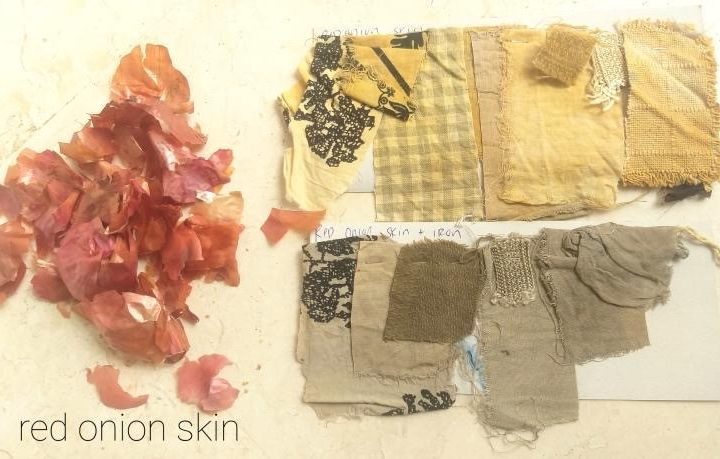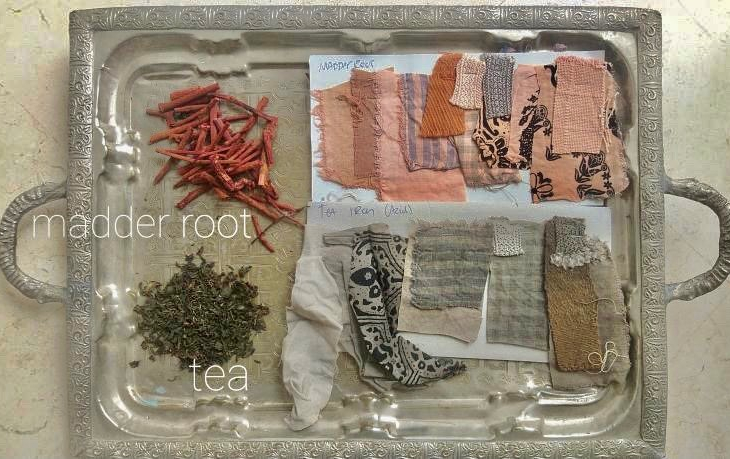Henri Matisse (Other Culture) – Hassan Hajjaj (Shared Culture) –
Mushmina™ (Sharing Culture)
Written jointly by Dr Sheila Christofides PhD Art History, who wrote the posh bits and Cara, who wrote the tidbits.
©AIMT™

Babouches for sale.
Colour is resplendent in Morocco. It is in the zellige hand-made tiles of your riad. In the vats of the tanneries. In the carpets. Even particular towns are associated with different colours. Marrakech with red. Chefchaouen with blue. Fez with green, which is also the colour of Islam. That’s the old Morocco. The intriguing and sensorily saturated Morocco and one that still exists today, despite the inevitable and impending encroachment of global modernity, evermore present as time ticks on inexorably.
This blog post is about that glorious cacophony of colours which can be seen as reflected in even the food and, of course, the art that this lusciousness has inspired. The colours range from the richness of bright pigments to the more muted tones of nature seen in some artisanal products, reflective of the arid landscape that you will observe when you are not in the coastal and mountainous areas.

Luxury Tagines for sale
Of the artists who have drawn inspiration from Moroccan life, perhaps the two most famous are Henri Matisse and Hassan Hajjaj. The first from consecutive visits in 1912 and 1913, and the second from being immersed in the culture as a child and a continuing connection over the years.
Henri Matisse- yes again, sorry, we love his work – but it is only a couple of paragraphs
By the time Matisse first went to Morocco, he had (along with André Derain) already been a leader of the short-lived Fauvism movement and travelled to Algeria. Even prior to this, in his formative Neo-Impressionist period, he had begun exploring the juxtaposition of intense colours. As a Fauvist, the colours became a means of breaking down the pictorial space so that the background and foreground appear to merge on the same plane.
Three paintings from 1912, 1912-13 and 1913, demonstrate how Matisse’s sojourn in Morocco has been used to further explore the use of colour in creating the abstract impression of flatness while at the same time absorbing something of the culture. Respectively these paintings are Zorah on the Terrace, Le Rifain assis and La glace sans tain (The Blue Window).

Zorah on the Terrace, 1912, oil on canvas, 116 x 100 cm. The Pushkin Museum of Fine Arts, Moscow, Russia

Henri Matisse, 1913, La glace sans tain (The Blue Window), oil on canvas, 130.8 x 90.5 cm, Museum of Modern Art. New York.
Of the three, the use of colour in the portrait of the “Rifain” (Berber from the Atlas Mountains), which appears further below, is the most intriguing, as the sitter’s legs appear to disappear into the background. Gone now are the ultra-bright colours of Fauvism to be replaced with the muted tones of dulled-down oranges, yellows and greens. Perhaps Matisse had visited the south, where the harsh light and sand in the air washes out the luscious visual palette of everyday scenes.

Even here the colour is enriched by the late afternoon sun compared with the more sun-washed appearance of the landscape when the sun is higher in the sky.

Le Rifain assis, 1912, oil on canvas, 78 7/8 x 63 1/4 in. (200.3 x 160.7 cm), Barnes Foundation, Philadelphia, PA
If you would like to consider coming with us to follow the footsteps of Matisse, along with Delacroix and Dali in Morocco, you can start by reading about what we are offering, here.
Hassan Hajjaj
Unlike Matisse, Hassan Hajjaj is an insider – and his work reflects this. With Matisse, we get the feeling that his sitters are exotic – the “other”, whereas with Hajjaj the sitters are clearly in on a celebration of a shared culture. We are no longer voyeurs, but eager participants in a side of Moroccan life that is fun and so contemporary.
Hajjaj’s portraits of Moroccans drip with colour, conjuring a vibrance reflective of the cacophony that includes the sounds and smells of the Moroccan experience. Everything from the vivid food in the tagines and on market stalls. The brightly coloured sweets. The clatter and chatter of everyday life in the souks and narrow streets. Desert music and calls to prayer. The aromas of hashish, camel dung and baking bread.

Sheep sales at Rissani Markets in the South.
Moving to London at the age of 12, Hajjaj now divides his time between the two places, owning a riad in Marrakech and a home in London. In a sense, his portraits are a fusion of both cultures, but his work also owes much to the legacy of Pop Art and he has earned the moniker “the Andy Warhol of Marrakech.” Amongst his many projects is a clothing line called “Andy Wahloo.”
One of his best-known works is the photo series “Kesh Angels” (2000), which depicts young, veiled women sitting astride motorbikes wearing long gowns and traditional slippers. But this is no gratuitous touristy posing as the women ride these bikes to get around and Hajjaj generally knows his sitters personally.

Kesh Angels, 2010. Photograph: Hassan Hajjaj/Vigo Gallery ‘They worked among the snake-charmers and belly-dancers of Marrakech. I christened them Kesh Angels and gave them heart-shaped sunglasses’
With only a slight nod to the past, their clothing (designed by Hajjaj) is patterned with camouflage, polka dots, animal prints and includes some traditional fabrics. Some of the women are decked out in brightly coloured sunglasses. This is modern Morocco. The fusion of yesterday and today.
We talk about visiting Hassan Hajjaj’s work in Marrakech on our “Following the Footsteps of Artists” tour here under the subheading “Three Nights in Marrakech”.
For some more of his gorgeous images you can also check out his Instagram profile here.
Mushmina™
More subdued and traditional is the work of artisanal workshops such as Mushmina which uses a range of natural plant material as dyes. The workshop is based in Boujad, a small rural town of 50,000 known for its rugs and nestled in the semi-arid Atlas Mountain countryside just 2 hours’ drive from Casablanca and 3 hours from Marrakech. It is run by an American lady called Heather, who first came to Morocco as part of the Peace Corps, married a Moroccan and now lives there with him and their 2 dear little children.
The materials used in Mushmina’s dyeing process include an alum or tin mordant for setting the colours and locally sourced ingredients such as henna, eucalyptus, madder root, onion skins, tea, pomegranate skins, red cabbage, black beans, and turmeric to produce the colour for fabrics and rug material.

© Mushmina

© Mushmina
With shades of the local landscape, the colours produced include a vibrant yellow from turmeric, a subtler yellow from red onion skin, and a more acid dull yellow from pomegranate skin, delicate orangey colours from madder root, and delicate greys and browns from tea and eucalyptus.

© Mushmina

© Mushmina
While you cannot take home a Matisse from your travels and a Hajjaj might be out of your price range, you can certainly take home an original dyed-in-the-wool rug or other artefact from Boujad for a wonderful memory of that holiday of a lifetime you once had in Morocco. If you are interested please contact us about an adjustment to either Tour 1 (7 days), outlined here or 5 (which extends Tour 1 to 10 days). Alternatively you can order one of these carpets from Mushmina online. Guaranteed legit.
Published September 2021
